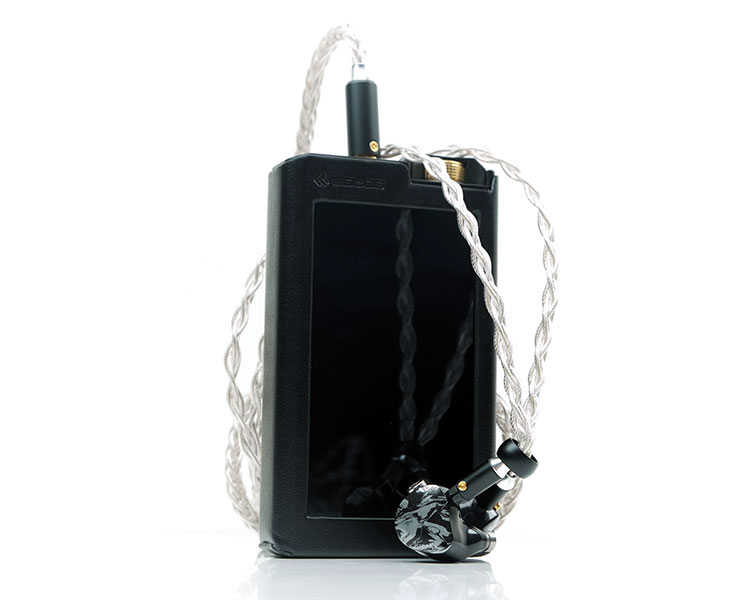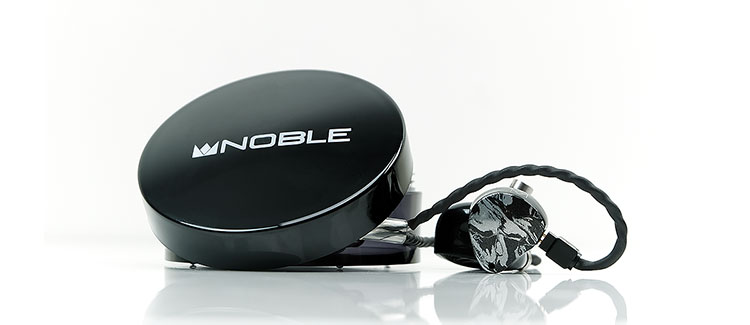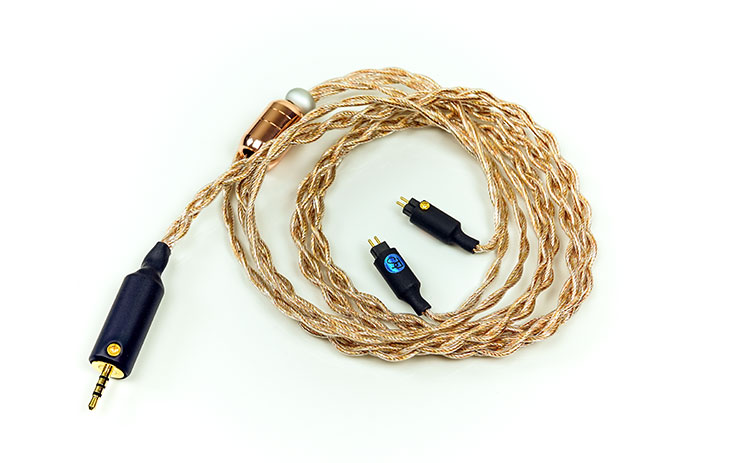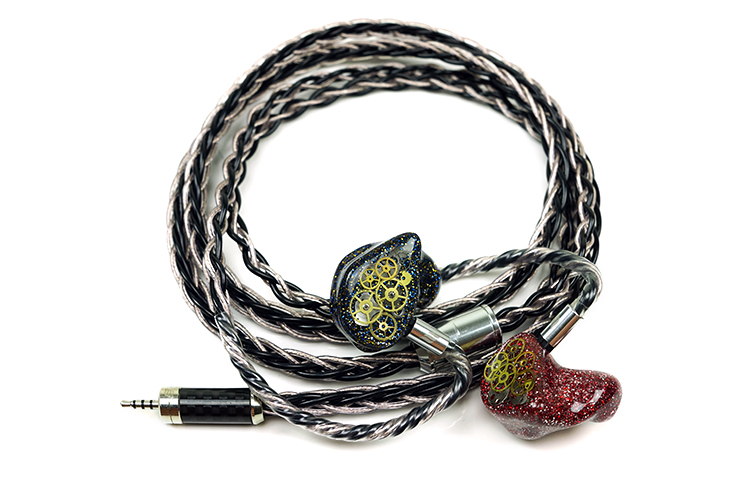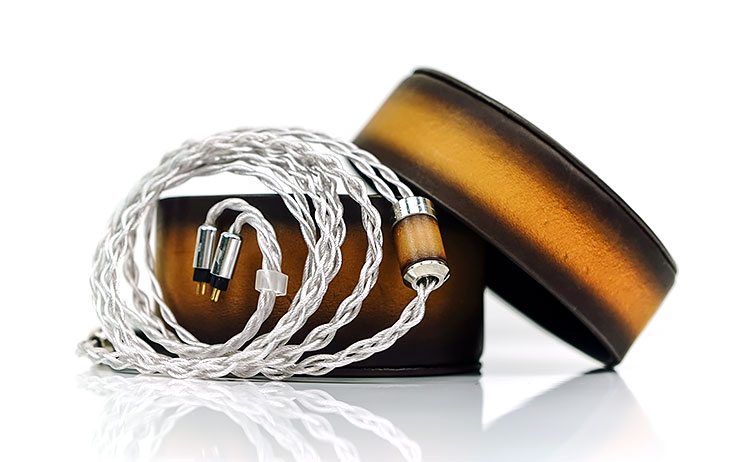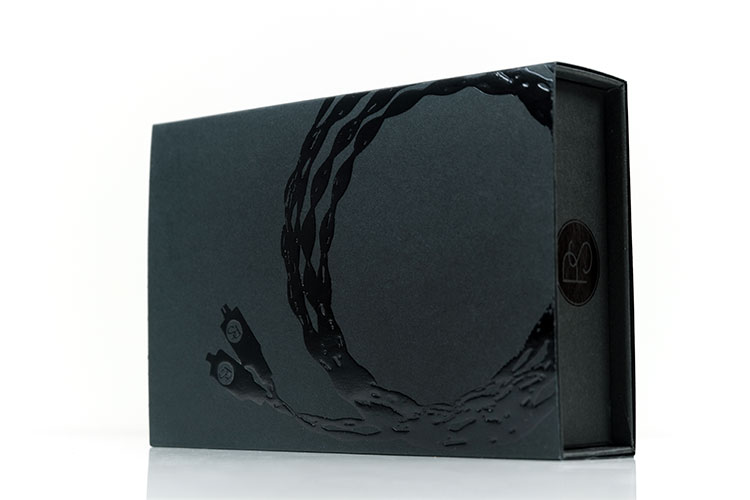Sound Impressions
Core Traits
In a way, the Tri-Silver walks in the same direction as Effect Audio’s Leonidas II. However, whilst I would say both have a strong emphasis on creating a very holographic yet natural sound there are some qualitative and technical differences between the two cables which I will speak about in our direct comparison below.
The bottom line is that the Tri-Silver is an incredibly detailed, engaging but also a relatively neutral-sounding cable. This is a cable that really focuses on staging capability, teasing out a really holographic presentation with a tuning that shies away from coloring the sound with much treble sparkle or low-end girth.
The monitor you use will ultimately produce the final flavor in terms of low-end weighting or treble density. No cable will completely change the character of a monitor but in each test case, we found both the dynamic range and the teasing out of a very immersive imaging level to be fantastically engaging on the Tri-Silver.
Dynamic Range
The first immediately noticeable improvement is in the technical domain with this being an 8-wire. I am always a big fan of a well-built 8-wire cable. I do believe that by and large, they will always sound superior to the same 4-wire build. It is also one of the reasons why I rated EA’s Janus Dynamic so highly last year.
The same goes for the 8-wire Tri-Silver cable. Using a decent quality SPC 4-wire cable, (stock cable from the Noble Khan), as our control wire the difference between the two builds was immediate.
The better dynamic range was palatable on the Tri-Silver with the SPC 4-wire sounding a little dull, lacking in speed and micro-detail by comparisons. The Tri-Silver expanded soundstage from front to back was most noticeable when comparing to the 4-wire producing a far better perception of depth, width, and most importantly, air.
Detail
The detail on each track we used was also much easier to pick up on the 8-wire Tri-Silver compared to the 4-wire equivalent test SPC cable. I always tend to find anything that teases out a superior level of dynamic range will invariably bring out a better level of performance for micro-detail.
What the Tri-Silver does so well is not just picking out and delivering a high level of detail but also delivering it in a very 3-dimensional or holographic manner. This is where shades of Leonidas 2 come into play but with additional dynamic range and a slightly drier tone.
‘Will’
A good example of this switch-up compared to the 4-wire SPC cable is one of my favorite tracks in the office right now by FAVORIT89 called “Will”. This is a fairly aggressive synth-wave track but with this gorgeous ’80s style sax loop floating over the top at key points and plenty of key changes throughout.
Here we tested this track using a Cozoy TAKT PRO going OTG from a Huawei P20, a Lotoo Paw Gold Touch, and a set of A18s from 64 Audio in an unbalanced format.
With the SPC 4-wire, the sound was smooth and warm to my ear and generally quite agreeable but the sax loop lacked texture and space to shine from the otherwise ‘heads-down’ speedy BPM of the background electronic rhythm.
The soundstage was also a little more centered and focused and I think this track needs as much width and instrumental separation it can get to really shine. In short, it sounded a bit ‘flat’.
Switching to the Tri-Silver I lost a little of the low-end warmth from the SPC but I got far better definition and clarity from that superior dynamic range performance. The mids instrumental layering and separation were also a huge leap forward.
To my ears, the track’s presentation was much more 3-dimensional and immersive sounding. Suddenly, the sax loop had texture and detail and a lot more space to breathe. It was far easier to figure out exactly where that sax was positioned which was slightly to the upper part of the rear of the stage.
Synergy
There were two pairings that leaped out to me during our testing in terms of how I felt they best represented the Tri-Silver’s strengths and weaknesses. This was the stage monster from 64 Audio, the A18 and Noble’s latest flagship, the piezoelectric-infused hybrid Khan.
64 Audio A18
An absolutely superb pairing and probably the best I have heard yet from the A18 in terms of imaging, detail, and treble presence. The A18 paired very well with the Leonidas 2 in our last review so I had a feeling this would be a good one and it does not disappoint.
The A18 is a masterful monitor for the level of detail it can convey inside a very large staging experience. Much like Leo 2, the Tri-Silver takes total advantage of these traits to deliver one heck of an immersive 3-dimensional presentation with the A18. Every drop of detail is there and delivered in a vivid and impactful manner.
Just like Leo 2 though this is not a pairing if you want to fatten up the sound or ass some low-end heft and it is a touch drier also. I honestly do not mind one bit when I can hear details as clearly as this.
Noble Audio Khan
I was initially on the fence with this pairing because of how the Khan reacted with sources and tips once the stock cable was taken out. The reason for that is the stock SPC cable is quite mellow, more laid back, and in a way that suits the treble tuning of the Khan.
The Khan has excellent treble presence and body but this is a delicate balance because if you push it too hard or suck out the warmth from the low-end dynamic driver and it can sound harder, more strident, which some may find less appealing.
With foam tips and the reference Lotoo PAW Gold Touch DAP, I found the treble presence and a dominant odd-harmonic overtone when paired with the Tri-Silver.
Not to the point where it become sibilant but certainly a lot drier sounding. Switching to the Exo Tri-Copper brought a little more wetness and low-end body into the presentation which might be a better indicator of the type of pairings the Khan will generally work best with.
Warmer DAPs such as the tube-powered Cayin N8 also brought a better balance between all the components. This pairing allowed the Tri-Silver/Khan pairing to really show off some excellent treble clarity without that initial hardness present with the Lotoo.
Select Comparisons
All comparisons were done with a 64 Audio A18, EE Phantom, and the Noble Audio Khan using the Lotoo PAW Gold Touch and Sony NW-WM1Z as sources with FLAC 16BIT/44.1K tracks.
PLUSSOUND Exo Series Tri-Copper
$549
Technical
The Tri-Copper is not quite the same mix of platings as the Tri-Silver. It is still a 26AWG Type 6 Litz gauge wire with that excellent PS Sound PVC insulation jacket, however, the 3 copper mixes are UP-OCC copper, silver-plated copper, and gold-plated copper. There is no palladium plating in this variant.
Also, the finish is last-gen in terms of heat-shrink materials and the more obvious strain relief finishing which gives it more of a DIY look compared with the beautiful snake-like handling of the Tri-Silver. The new jacks and barrels make a huge difference on the Tri-silver with a far more premium look.
Performance
The dynamic range is already very good on the Exo Series Tri-Copper, however, the 8-wire build of the Tri-Silver takes it to another level. You get a more vibrant and expansive sound on the Tri-silver compared to the smoother laid back Tri-Copper. I would love to see how this compares to an X8 8-wire Tri-Copper where I think the comparison would truly hold water.
That being said the Tri-Copper’s richer, thicker sound does have some great low-end body which the Tri-Silver tends to even out a little in favor of better instrumental separation and that enhanced holographic soundstage.
It does go very deep when required and when it does the definition and layering is much better than the Tri-Copper 4-wire so it actually sounds deeper just not as much timbral warmth. PLUSSOUND has done a good job of keeping the Tri-Silver relatively natural and easy on the ear rather than overtly clean or bright.
You will also hear a lot more detail with the Tri-silver and a much more complex soundstage from back to front over the Tri-Copper. The Tri-Copper sounds a lot more centered and weighted and not as airy or immersive as the Tri-Silver with monitors like the A18 which scale up wonderfully well for staging with a good cable.
The Tri-Copper will give you some additional body on the A18 which some may prefer but for me, the huge staging and imaging performance of the Tri-Silver is more appropriate.
Effect Audio Janus Dynamic
$1399
Technical
The Janus Dynamic is a larger wired 24AWG build and also uses palladium plating but this time with two types of copper rather than 3 silver. The copper used in the Janus dynamic is a Palladium Plated copper combined with an in-house mix of gold-plated copper and a gold-alloy. The two types of wire are then sheathed in a striking two-tone EA Ultra-Flex PVC jacket.
This is not a single 8-wire cable since there are two distinct mixes or strands. This is a ‘4-4’ wire split between the PPC side and the EA GPC black jacket side. It still all comes together as an 8-wire though so it will have all the hallmarks of an 8-core cable including a superior level of dynamic range to 4-wire variants.
Build
The Janus’s larger AWG does mean that it is the slightly heavier of the two 8-wire cables as well as having a slightly looser braiding throw compared to the Tri-Silver. The Tri-Silver’s 26AWG means that it handles the slightly better of the two though both have excellent microphonic and no memory retention.
The use of memory wire on the Janus is a slight drawback over the memory wire-free Tri-Silver. The Tri-silver does feel the more pliant of the two and comfier on the ear without that memory wire.
I have a slight preference for the chrome-finished y-splitter barrel on the Janus. The etched branded finish is that bit more striking than the Rosewood of the Tri-Silver.
However, I much prefer the new jack and connector barrels of the Tri-Silver over the equivalent Janus 2-pin barrels. The Janus EA chrome barrels feel too light and easy to slide off with the glue finish compared to the compact screw-in builds of the Tri-Silver.
Performance
There are two very distinct tonal and tuning differences between these two 8-wire monster cables. However, before going into them specifically I did want to say that technically both compete just as well in terms of dynamic range and detail.
The slightly larger cable size of the Janus (24AWG) compared to the Tri-Silver might just have a small edge in volume levels but otherwise, the gap is negligible.
Tonal Balance
The two distinct differences are in the timbre of each cable using the same monitors to test (A18, Khan, and VE8) and the tonal balance. The Janus is thicker sounding, richer with more bottom end weight. The PLUSSOUND Tri-Silver is cleaner, airier, and more neutral in its presentation.
The Janus is closer in tonal balance to the Exo Tri-Copper only with a much better dynamic range and a wider soundstage. The Tri-Silver sits in the Leo 2 camp with a lighter airier touch at times but with wonderful staging properties.
Timber
The timber on the Janus is natural to slightly euphonic sounding throughout for both instrumental and vocal timbre with a slightly centered and forward vocal presence quality. Imaging is great, a speaker-like presentation in a way with excellent instrumental separation.
The Tri-Silver timbre is leaner, lighter but still relatively soft enough to sound fairly natural to my ear and not bright or harsh like some pure silver Litz cables I have heard before.
The staging of the Tri-Silver is not quite as deep sounding or as powerful as the Janus low-end on all monitors tested but it does deliver a more holographic presentation and slightly more air than the Janus Dynamic.
Preferences
Of the two the Janus Dynamic rumbles better, perhaps more musical in a way whereas the Tri-Silver has a slightly more ethereal swirling quality and a quicker sounding signature. The pairing of these two cables is really down to personal preferences.
Personally, I am sticking with the EE Phantom and Janus Dynamic because I love that analog-rich smooth sound they deliver and the Tri-Silver more often than not is on the end of the 64 Audio A18 because of its huge staging potential.
Effect Audio Leonidas II
$888
Technical
Like the Tri-Copper, the Leonidas 2 we have here is a 4-wire build. At the time of writing, there is no available 8-wire build but we hope and pray there is because that would be the true competitor to the Tri-Silver 8-wire X8. The reason for that is due to it also using palladium-plated silver wiring and to be honest, both have a similar goal in terms of how they go about presenting sound.
The Leo 2 is a 26AWG UP-OCC 4-wire in a 7-core bundled Litz type configuration. The wiring metals include a palladium-plated silver & Litz silver hybrid wire mix wrapped in EA Ultra-Flex PVC jacket.
Build
The build is of course much lighter than the 8-wire Tri-Silver but both braidings are equally tight and well done. Neither cable suffers from microphonics but the smaller wire of the Leo 2 shades it in terms of low physical noise. Physically that should not be a surprise s there is more cable to “poke” on the Tri-Silver.
Like the Tri-silver the Leo 2 uses a translucent jacket and the effect is just beautiful on both with a striking off-silver shimmer. Both cables have accented the shimmer with organic tones on their Y-splitter barrels with the Leo 2 edging it for me with that patina-style leather wrap on chrome barrel.
The Rosewood is plenty nice also on the Tri-Silver but it is bulkier and not quite as unique looking. The fact the Leo 2 comes with a matching patina-style leather carry case is the icing on the cake.
Barrels
As per my comments on the Janus, I do prefer the jack and connector barrels on the Tri-Silver compared to the Leo 2. The Leo 2 uses the same barrels as the Janus. The Tri-Silver barrels just feel stronger, less likely to come apart, and lacks any obvious strain relief finishing which helps a lot in terms of aesthetics.
The Leo 2 also uses a little memory wire for ear shaping but given it’s a smaller 4-wire it is not as obvious as on the Janus. Again, the lack of memory wire on the Tri-Silver is a big bonus for me and makes it almost as comfy as the smaller Leo 2 wire despite being bigger.
Performance
Despite the 8-wire vs 4-wire build I do not find the dynamic range and volume differential gap to be that big between these two cables. That does not mean there is not a difference. There is, just not as big as you might find on a regular 4-wire OFC Plastics One variant. Testimony indeed to the quality of the Leonidas 4-wire quality.
Commonalities
Both of these cables are aiming for the same target in terms of presentation. Both tread a more balanced natural sound with a fairly linear low-end and a smooth treble delivery. More importantly, both want to deliver a 3-dimensional holographic soundstage with excellent imaging with most monitors, especially the 64 Audio A18 and the Noble Khan.
Differences
Where do they differ then exactly? For me, the difference can be mainly felt in how both deliver their low-end and treble as well as some nuanced differences in their timbre. The Leonidas has a slightly sweeter wetter timbre of the two whereas the 8-wire Tri-Silver has more body, more sub-bass presence and power, and a slightly drier treble tone.
Any tracks with heavier hitting kick drums will display just a slightly better level of dynamic range meaning a bit more definition and better perception of depth on the Tri-Silver. The Leonidas 2 is the slightly softer of the two in the low-end.
On the flipside, there is a tiny bit more sparkle and lower treble note decay on the Leonidas 2 compared to the Tri-Silver when testing with treble kings, the 64 Audio A18. I have a feeling EA has allowed a bit more natural silver cleanliness to shine through on the Leo 2 whereas Plusssound has kept it in check a bit more opting instead for more treble body and a shorter decay.
Our Verdict
The PLUSSOUND Tri-Silver is a monster of a cable if you are into soundstaging and immersive imaging. Whilst it has a slightly timbral difference to the Effect Audio Leonidas 2 I strongly suspect an 8-wire version of the Leo 2 would pretty much be heading in the same direction.
Of course, that is the question, is there an 8-wire Leonidas 2 in the pipeline that can challenge the PLUSSOUND Tri-Silver for both dynamic range and 3-dimensional staging?
On the back of our review, I think there would need to be to provide some healthy competition. I do wish I have heard the Horus also just to gauge how other similarly priced cables can perform but for now, the Tri-Silver will take some beating.
Importantly it does provide something quite different from the Janus experience. Both are technically as good as each other but the Janus is all about that richer low-end body and mids whereas the Tri-Silver keeps it more neutral, slightly cleaner, and more holographic imaging.
Both have their champs in terms of monitor pairing, Janus for the Phantom and the Tri-Silver for the 64 Audio. Both will have their fans.
The final comment has to be about the new build quality. Quite fantastic for an 8-wire and so easy to work with. If PLUSSOUND really is applying this to all their cables then they rightly belong in the big leagues as of now.
PLUSSOUND Tri-Silver Technical Specifications
- Type 6 Litz – 26AWG 8-core wire
- Wire Mix – pure silver, gold-plated silver, palladium-plated silver
- PS insulation Jacket (no heat shrinks)
- Premium Rosewood y-split barrel, PS aluminum slider
- PS connectors Gold screen-printed logos
- Cable length (stock 1.3m/49″)





